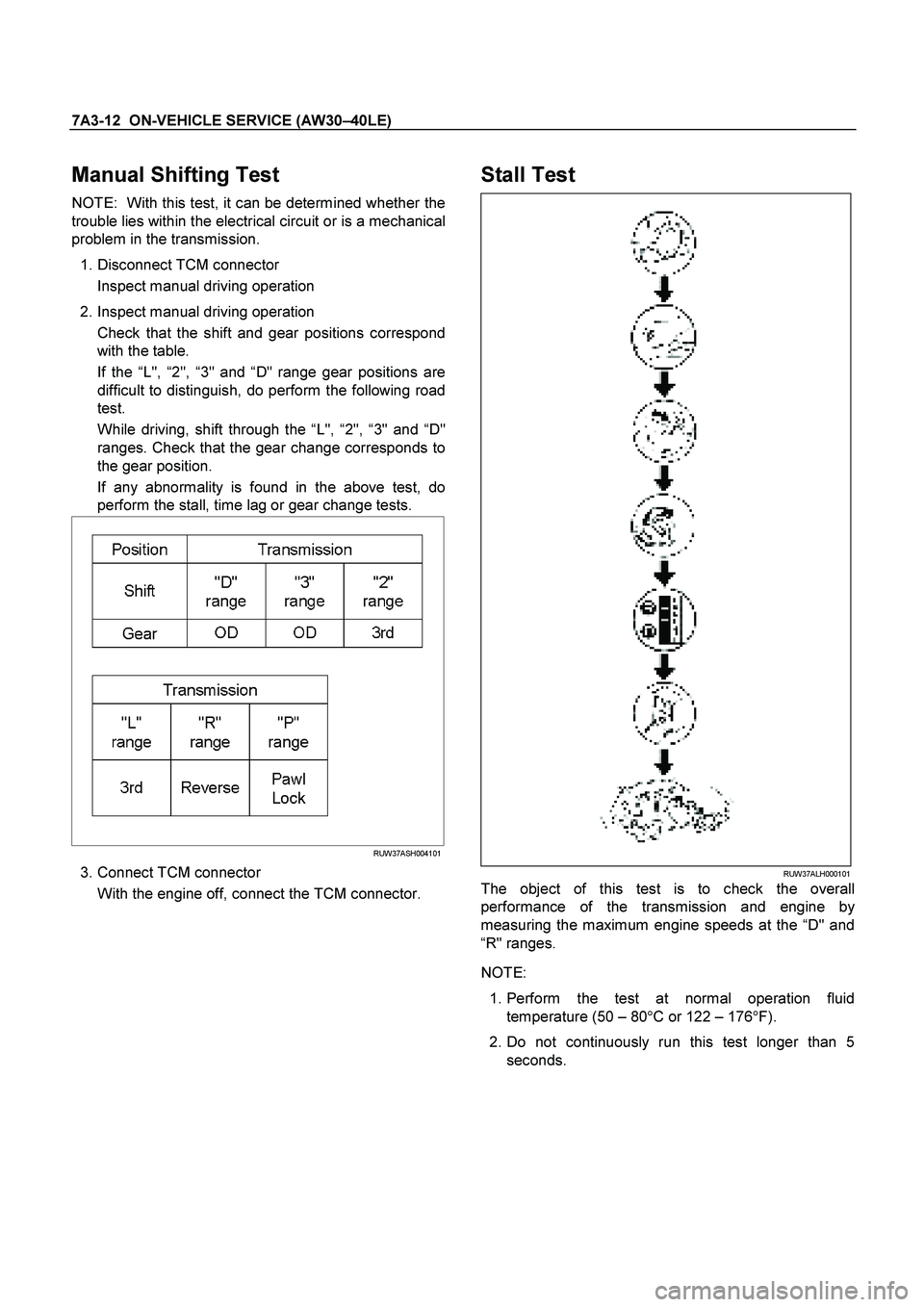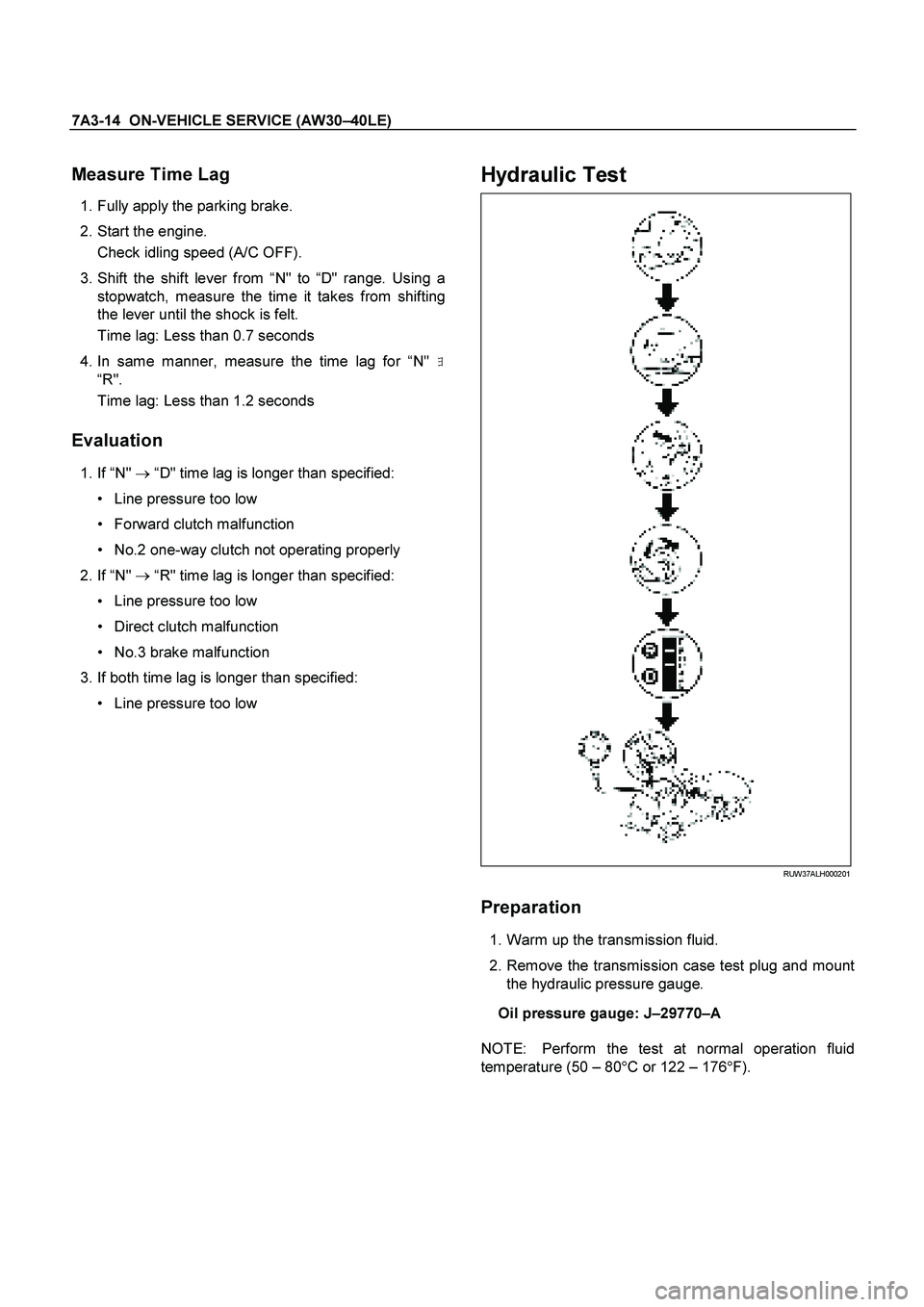ISUZU TF SERIES 2004 Workshop Manual
TF SERIES 2004
ISUZU
ISUZU
https://www.carmanualsonline.info/img/61/57180/w960_57180-0.png
ISUZU TF SERIES 2004 Workshop Manual
Trending: Cylinder head removal, manual transmission, reset, Glow plug, light, tow, oil additives
Page 3761 of 4264

ON-VEHICLE SERVICE (AW30 –40LE) 7A3-5
Speed Change and Lock-Up Pattern
If you select a speed as shown below by specifying
respective positions of transmission shift lever, transfe
r
switch and pattern select switch, the transmission
control computer controls speed change and lock-up
operations based on the specified pattern in accordance
with the degree of throttle opening and vehicle speed.
Pattern select sw. position Transmission shift position
D 3 2 L
NORMAL, POWER 1st �
[2nd] �
[3rd] �
[O/D] 1st �
[2nd] �
[3rd] 1st �
2nd�(3rd) 1st�(2nd)
3rd START 3rd fixing — —
[ ]: The lock-up operation is available.
( ): Transmission is shifted at high speed to prevent overrun.
Overdrive and Lock-Up Operating Conditions
The overdrive and lock-up clutch operate if the following
conditions are satisfied.
Overdrive Lock-up clutch
Shift pattern position
NORMAL NORMAL
Transmission shift position
D range ��
Brake lamp switch
— OFF
Throttle opening
Fully closed Except fully closed
Accelerator About 52 km/h (32 mph) or more 2nd: About 76 km/h (47 mph) or
more
Vehicle speed Deceleration About 42 km/h (26 mph) or more 3rd: About 56 km/h (35 mph) or more
O/D: About 67 km/h (42 mph) or
more
Page 3762 of 4264
7A3-6 ON-VEHICLE SERVICE (AW30 –40LE)
Diagnosis
Basic Troubleshooting
AW30
–40LE transmission, with Transmission Control
Module (TCM), differs from the Mechanical – Hydraulic
control type transmissions. Accordingly, its
troubleshooting procedure differs also.
Before troubleshooting an TCM, first determine whethe
r
the problem is electrical or mechanical. To do this, just
refer to the basic troubleshooting flowchart provided
below.
If the cause is already known, using the basic
troubleshooting chart below along with the
troubleshooting chart should speed the procedure.
F07R200005-X
Page 3763 of 4264
ON-VEHICLE SERVICE (AW30 –40LE) 7A3-7
Troubleshooting Chart
Numbers are arranged in order of probability.
Perform inspections starting with number one and
working up.
Page 3764 of 4264
7A3-8 ON-VEHICLE SERVICE (AW30 –40LE)
Page 3765 of 4264
ON-VEHICLE SERVICE (AW30 –40LE) 7A3-9
Page 3766 of 4264
7A3-10 ON-VEHICLE SERVICE (AW30 –40LE)
Page 3767 of 4264
ON-VEHICLE SERVICE (AW30 –40LE) 7A3-11
Page 3768 of 4264

7A3-12 ON-VEHICLE SERVICE (AW30 –40LE)
Manual Shifting Test
NOTE: With this test, it can be determined whether the
trouble lies within the electrical circuit or is a mechanical
problem in the transmission.
1. Disconnect TCM connector
Inspect manual driving operation
2. Inspect manual driving operation
Check that the shift and gear positions correspond
with the table.
If the “L", “2", “3" and “D" range gear positions are
difficult to distinguish, do perform the following road
test.
While driving, shift through the “L", “2", “3" and “D"
ranges. Check that the gear change corresponds to
the gear position.
If any abnormality is found in the above test, do
perform the stall, time lag or gear change tests.
RUW37ASH004101
3. Connect TCM connector
With the engine off, connect the TCM connector.
Stall Test
RUW37ALH000101
The object of this test is to check the overall
performance of the transmission and engine b
y
measuring the maximum engine speeds at the “D" and
“ R" ranges.
NOTE:
1. Perform the test at normal operation fluid
temperature (50 – 80 �
C or 122 – 176 �
F).
2. Do not continuously run this test longer than 5 seconds.
Page 3769 of 4264

ON-VEHICLE SERVICE (AW30 –40LE) 7A3-13
Measure Stall Speed
1. Chock the four wheels.
2. Mount an engine tachometer.
3. Fully apply the parking brake.
4. Step down strongly on the brake pedal with your left foot.
5. Start the engine.
6. Turn off the A/C.
7. Shift into the “D" range. Step all the way down on
the accelerator pedal with your right foot. Quickl
y
read the highest engine rpm.
Stall speed: 2100 �
� �
�
150 rpm
8. Perform the same test in the “R" range.
Evaluation
1. If the engine speed is the same for both ranges but
lower than the specified value:
Engine output is insufficient.
Stator one-way clutch is not operating properly.
NOTE: If more than 600 rpm below the specified value,
the torque converter could be faulty.
2. If the stall speed in “D" range is higher than
specified:
Line pressure too low
Forward clutch slipping
No.2 one-way clutch not operating properly
3. If the stall speed in “R" range is higher than
specified:
Line pressure too low
Direct clutch slipping
No.3 brake slipping
4. If the stall speed in the “R" and “D" ranges are
higher than specified:
Line pressure too low
Improper fluid level
Time Lag Test
F07RY00003
If the shift lever is shifted while the engine is idling,
there will be a certain time elapse or lag before the
shock can be felt. This is used for checking the
condition of the forward clutch, direct clutch, No.3
brake, and No.2 one-way clutch.
NOTE:
1. Perform the test at normal operation fluid
temperature (50 – 80 �C or 122 – 176 �F)
2. Be sure to allow one minute interval between tests.
3. Make three measurements and take the average value.
Page 3770 of 4264

7A3-14 ON-VEHICLE SERVICE (AW30 –40LE)
Measure Time Lag
1. Fully apply the parking brake.
2. Start the engine. Check idling speed (A/C OFF).
3. Shift the shift lever from “N" to “D" range. Using a
stopwatch, measure the time it takes from shifting
the lever until the shock is felt.
Time lag: Less than 0.7 seconds
4. In same manner, measure the time lag for “N"
�
“R".
Time lag: Less than 1.2 seconds
Evaluation
1. If “N" �
“ D" time lag is longer than specified:
Line pressure too low
Forward clutch malfunction
No.2 one-way clutch not operating properly
2. If “N" �
“ R" time lag is longer than specified:
Line pressure too low
Direct clutch malfunction
No.3 brake malfunction
3. If both time lag is longer than specified:
Line pressure too low
Hydraulic Test
RUW37ALH000201
Preparation
1. Warm up the transmission fluid.
2. Remove the transmission case test plug and mount the hydraulic pressure gauge.
Oil pressure gauge: J –29770 –A
NOTE: Perform the test at normal operation fluid
temperature (50 – 80 �
C or 122 – 176 �
F).
Trending: tow, instrument panel, Firing, wheel bolts, maintenance schedule, spark plugs, load capacity









